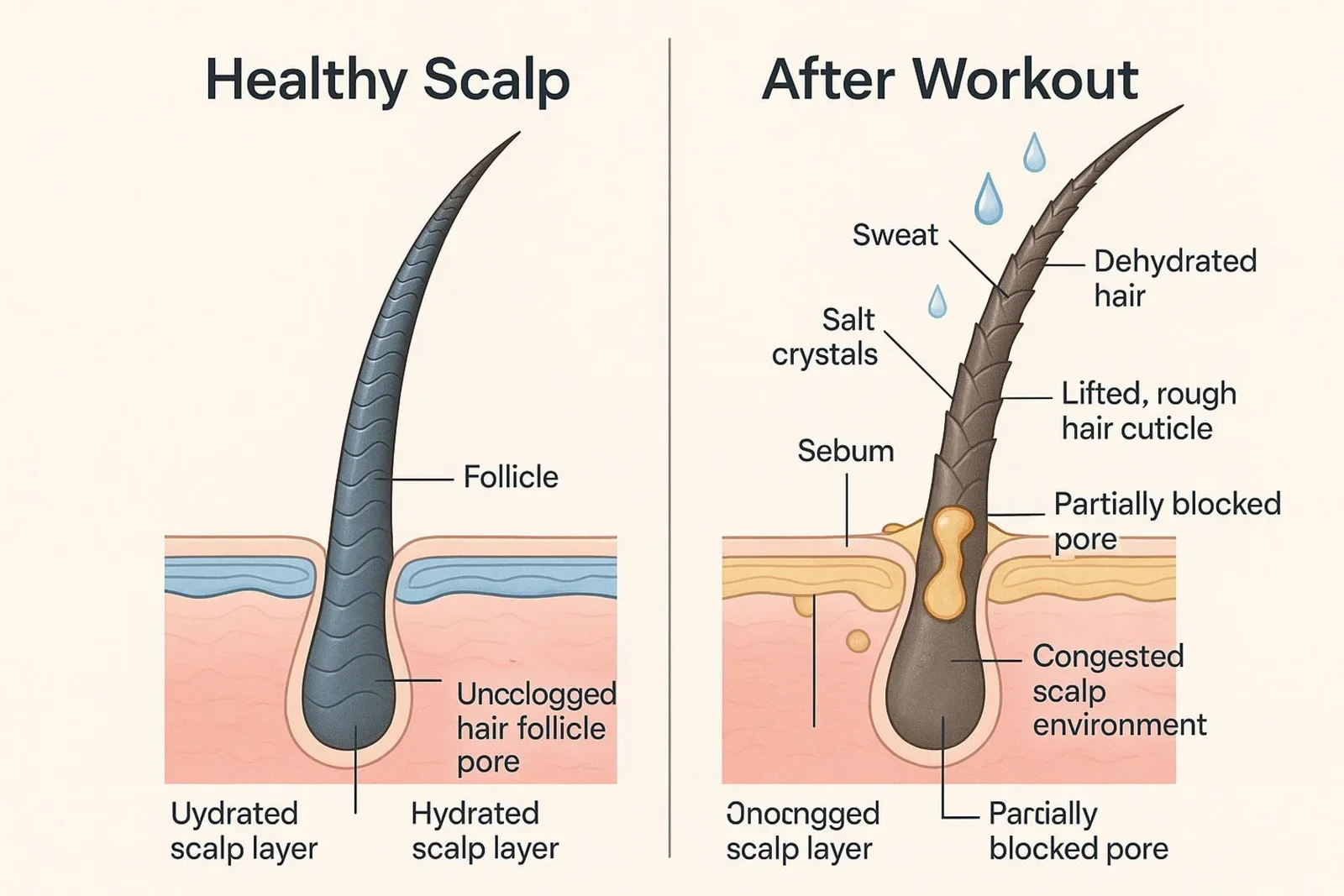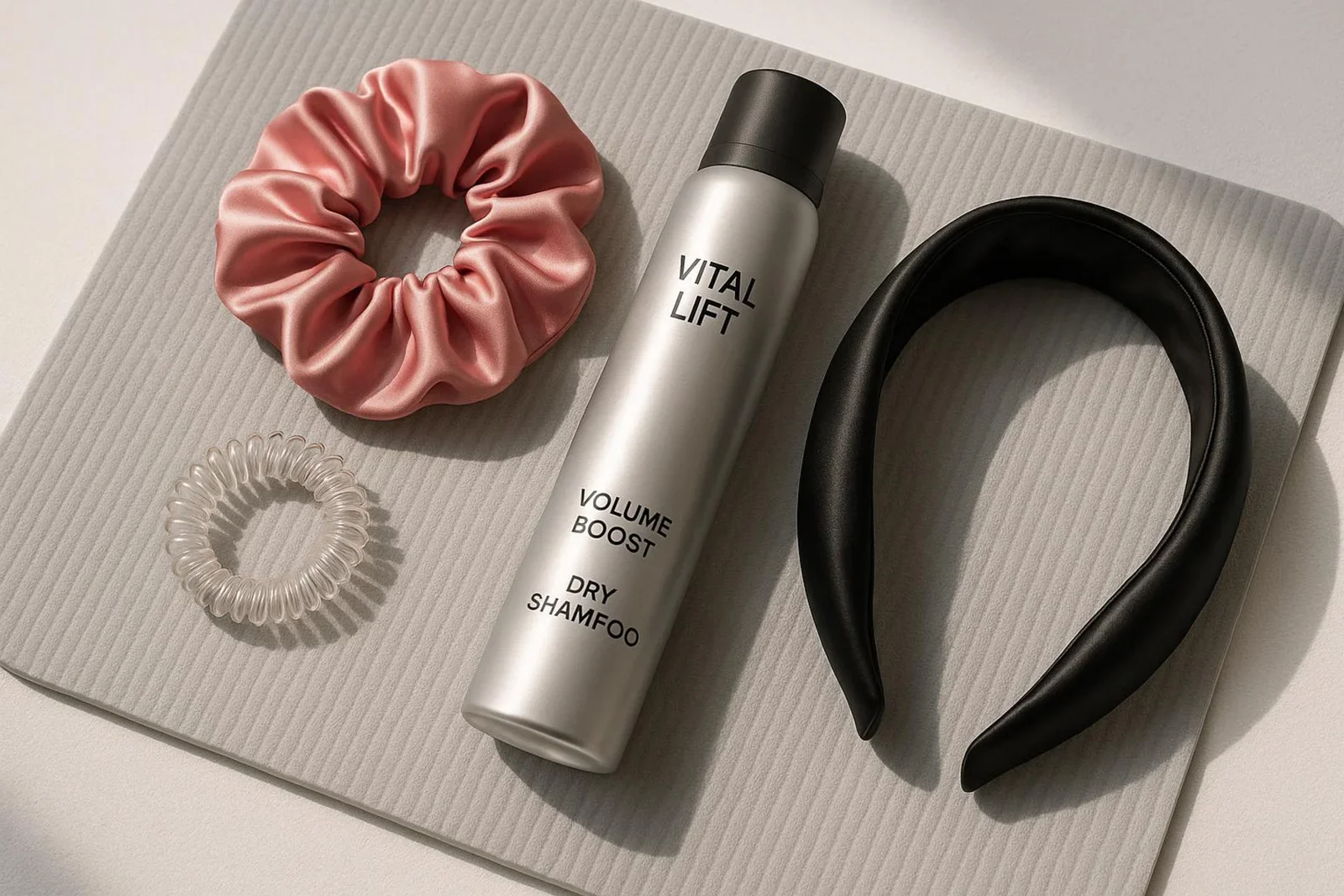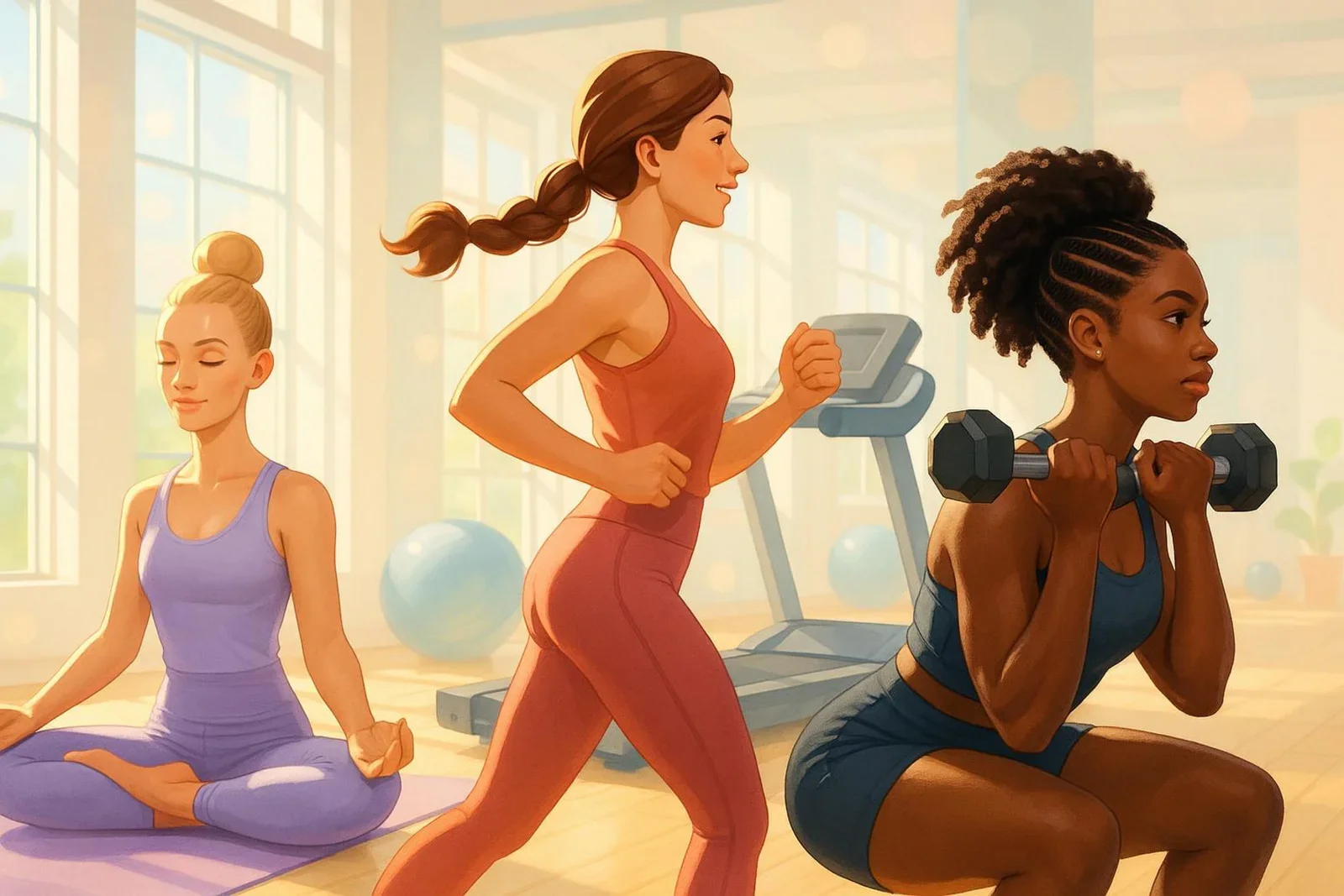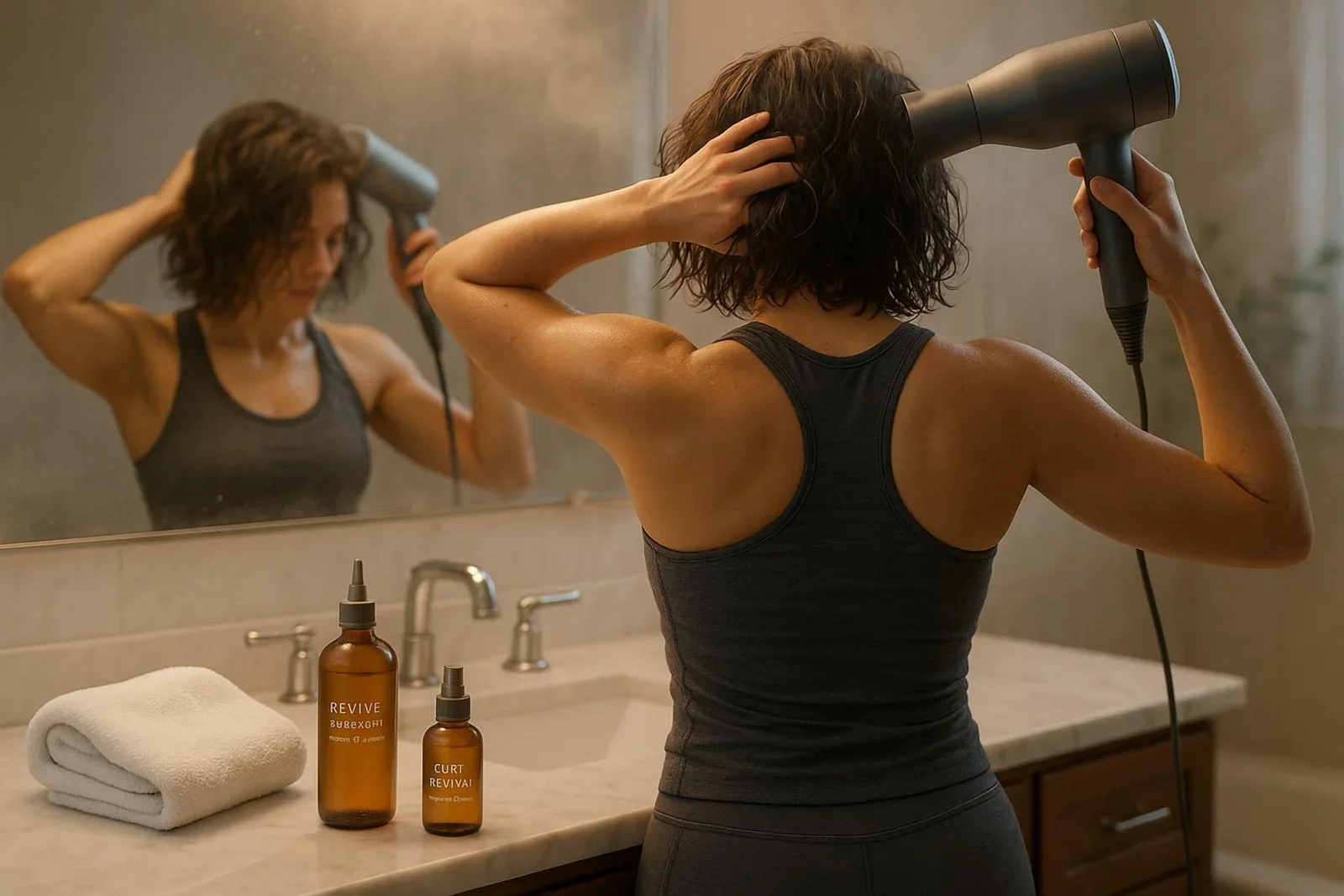How to Protect Your Hair When Working Out
Regular exercise is great for your body and mind. Gym sessions, runs, and yoga classes all help, but your hair can take a hit if you don’t plan ahead. The good news: you can keep your hair looking good and still hit your fitness goals. Use a few simple steps before, during, and after your workout to keep sweat, friction, and tight styles from causing damage.
Why Sweating During Exercise Affects Your Hair
Sweat itself isn’t bad for hair. Scalp sweat can boost blood flow, clear pores, and support growth. Problems usually start when sweat sits on the scalp and dries, or when hair is handled roughly around workout time.
How Does Sweat Impact Hair Health?
Sweat contains salt and minerals. Left to dry, it can mix with oils, bacteria, and dead skin, which may lead to itch, flakes, and irritation. Dried salt on strands can also make hair feel dry or brittle. Think of how salt water dries on a surface and leaves a film; hair reacts the same way.
Sweat mix: salt + minerals + oils + bacteria + dead skin
Scalp effect: itch, flakes, clogged pores
Hair effect: dryness, rough feel, higher breakage risk
Workout habits can add stress too. Tight ties, rough brushing, and styling wet, sweaty hair raise the chance of breakage. You want hair off your face but without pulling hard on the same spots.
What Are the Risks for Different Hair Types?
Hair type changes how sweat shows up:
| Hair type | Common workout issues | Tips |
|---|---|---|
| Fine/straight | Greasy roots, flat volume | Wash every 1-2 days; use dry shampoo pre-workout |
| Wavy | Frizz, limp roots | Use dry shampoo at roots; light conditioner on ends |
| Curly/coily/textured | Dryness, frizz, brittleness | Wash less often; add oils or leave-ins; protect styles |
Curly and coily hair is naturally drier, so salt can make dryness and frizz worse. Protective styles like braids or extensions take time and money, which can make frequent restyling hard. Many people worry about “sweating out” a set style. A 2013 survey found that hair concerns keep many Black women from exercising, showing how real this issue is.
Common Hair Concerns Linked to Exercise
Exercise can cause more than damp roots. Without smart care, sweat, friction, and tight styling can lead to long-term problems.
Breakage, Frizz and Dryness
Wet hair stretches and breaks more easily. Add movement, tight ties, or rough brushing and damage builds. Salt in sweat also adds dryness, which can lift the cuticle and cause frizz and a halo effect. Repeated tight ponytails can cause a “U” shaped break where the elastic sits.
Colour Fading and Dulling
Frequent sweat and washing can fade colour faster, especially without colour-safe products. Outdoor workouts under strong sun speed this up and leave hair dull.
Scalp Issues: Flaking, Itchiness or Oiliness
Dried sweat mixed with oils and debris can lead to itch and flakes. Oily scalps may feel greasy sooner. Dry scalps may feel tighter and more irritated. A healthy scalp supports healthy growth, so keeping it balanced matters.
More Frequent Washing and Its Drawbacks
Daily washes may seem like the fix but can strip oils, cause dryness, and lead to more breakage, especially with sulfate shampoos. It also takes time and uses products faster. You can keep clean without over-washing.
What Should You Do Before Working Out to Protect Your Hair?
A bit of prep before you sweat makes post-workout care much easier.
Apply Dry Shampoo or Scalp Treatments Pre-Workout
Use dry shampoo on roots before exercise. The powders (like rice or tapioca starch) can soak up moisture as you sweat, which works better than trying to fix damp roots later.
Lift sections and spray/puff at the roots
Let it sit 1-2 minutes
Lightly brush or massage to blend
Don’t like dry shampoo? Try a dry co-wash that absorbs sweat and adds light moisture. For curly or textured hair, a small amount of oil or a leave-in before a workout can reduce frizz and dryness from salt.
Choose a Protective Hairstyle
Keep hair off your neck (a major sweat zone) without pulling tight. Tight ponytails can cause breakage and sore roots.
Good options: braids, loose buns, plaits, twists
Curly hair: Puff Cuff or similar clip to gather curls without creases
Keep tension light to avoid stress on the same area
Use Silk or Satin Accessories
Material matters. Traditional elastics can snag, especially on wet hair. Softer options reduce friction and dents.
Ribbon ties and scrunchies (silk or satin)
Spiral coils (e.g., Invisibobble) that don’t soak up sweat
Headbands/scarves with silk or satin lining
Don’t tie headwear too tight. You want airflow so sweat doesn’t build up.
Best Hairstyles for Exercise
Pick styles that limit movement, cut down on sweat contact, and don’t pull hard on your strands.
Braids, Buns and Plaits
Braids, buns, and plaits hold hair in place and reduce rubbing. Braids let your scalp breathe more than tight buns. They fit under helmets for cycling and help avoid tangles during skiing. For textured hair, twists, cornrows, or braids can stay in for a week to cut daily handling.
High buns work well for Pilates so you can lie flat. A bun also pairs well with a treatment: apply a serum or mask, wrap into a bun, and let your body heat help it sink in.
Low Ponytails and Loose Styles
High, tight ponies can strain the same area. Rotate styles. Try a low pony or looser bun to reduce repeated stress. For curls, a loose “pineapple” on top keeps hair off your face and neck and limits sweat contact.
Switch your style day to day. If yesterday was a high pony, try a low braid today.
Avoiding Tight Hair Ties and Dents
Skip tight elastics. Hair tie damage often shows as a “U” shaped break where the band sits. Use snag-free ties, silk or satin scrunchies, or spiral coils instead. They hold well without dents or pain.
Secure but comfortable is the goal.
How to Protect Your Hair During a Workout
Small choices mid-workout can cut sweat and friction problems.
Wear Headbands, Scarves or Sweatbands
A barrier along the hairline helps catch sweat before it soaks in. This helps keep your fringe and face-framing hair dry and smooth.
Choose moisture-wicking, stretchy fabric
Brands with good options: Bondi Band, Nike, Lululemon
For curls: satin-lined wraps or headbands to lower friction
Keep them snug but not tight so your scalp can breathe.
Keep Your Hands Off Your Hair
Touching your hair can add oil and cause more frizz and breakage. Style it, then leave it alone. Keep a few bobby pins handy to clip stray bits. Sweep bangs to the side and pin if needed.
Protect from Sun and Chlorine
Outdoor workouts and swimming need extra steps. UV rays dry hair and fade colour. Use hair sunscreen or a leave-in with UV protection. Products like Kerastase Soleil UV Defense Colour Treatment can add a light shield and hydration.
Swimming tips:
Wet hair with clean water before you get in
Wear a swim cap
Rinse well right after your swim
Caring for Your Hair After Exercise
Post-workout care should freshen your scalp and hair without over-washing.
When to Wash and When to Rinse Only
Most people don’t need daily shampoo. Too much washing strips oils and dries hair.
Fine/straight: every 1-2 days
Wavy: every 2-3 days
Curly/coily: once or twice a week
On non-wash days, a water rinse helps remove salty buildup before it dries. Follow with a light conditioner on mid-lengths and ends to add slip and moisture.
Refreshing Hair Without Shampooing
After a rinse, use a cool hairdryer setting for a few minutes to dry roots and cool the scalp. Let hair cool before taking it out of a tie to reduce creases and frizz.
For braids: apply a soothing scalp tonic between parts
Use hair fragrance mists for odour and light shine
For curls: a water mist or curl refresher can bring curls back
Drying and Defrizzing Tips
Skip rough towel rubbing. Blot with a microfiber towel to cut friction. If you blow-dry, use a heat protectant and a cool or low setting. For straight or wavy hair, a light hair mist plus brushing or finger-combing can smooth out dents.
Have waves or curls? Work with them. After a workout, take hair down and gently tousle. Sweat’s sodium can act like a light sea salt effect, which can help form soft waves. For frizzy edges, a small amount of repairing edge control smoothed with an edge brush can help; some include biotin to support the hairline.
Deep Conditioning and Scalp Care
Sweat can dry hair out, so regular deep conditioning helps. Try a mask every two weeks. You can also apply a mask before your workout and wear a bun so heat helps it sink in.
For the scalp, use a weekly scrub or a cool mint or menthol product to refresh without harsh stripping. A micellar rinse with apple cider vinegar can lift oil without drying. Spray nozzles help reach roots under protective styles.
Choosing Hair Products Suited for Active Lifestyles
Pick formulas that work with sweat and movement without weighing hair down.
Lightweight, Sweat-Resistant Products
Use light products that don’t feel sticky.
Dry shampoo before workouts to absorb sweat early
Dry texture spray for oil control and volume
Root texturizer for grip if you wear hair down
Colour-safe shampoo and conditioner to slow fading
Ingredients to Avoid Post-Workout
Some ingredients can make sweaty hair feel greasy or dry.
Before workouts: skip heavy silicones that grab dirt and sweat
On wash days: avoid harsh sulfates for regular use; pick gentle, sulfate-free cleansers
Use a stronger clarifying shampoo only once a week if you get buildup
Extra Tips for Looking After Your Hair While Staying Active
Good daily habits make active hair care easier.
Making a Wash Schedule That Suits Your Routine
Set a simple plan so you don’t wash every time you sweat. Balance clean roots with keeping natural oils.
Rotate: full wash, root rinse, dry shampoo days
Co-wash on light sweat days, shampoo less often
Bring your own gentle products to the gym or save full washes for home
Hydrating and Eating Well for Hair Health
Drink water and eat a balanced diet with protein, vitamins, and minerals. This supports growth and keeps your scalp and strands in better shape, especially if you sweat a lot.
Embracing Your Natural Texture
Work with your hair’s natural pattern. Sweat can bring out waves and curls for a soft, beachy look. Pick styles that fit your texture to save time, reduce heat styling, and use fewer products.
When to Seek Professional Advice
If you have ongoing scalp problems, major breakage, or shedding that doesn’t improve, see a dermatologist or a trusted stylist. They can check for causes, suggest treatments, and build a plan that fits your hair type. For heavy scalp sweating, some people with hyperhidrosis use Botox in the scalp to reduce sweat and stretch time between washes.
Your fitness plan and your hair can work well together. With smart prep, gentle styling, and easy post-workout care, you can stay active and keep your hair healthy.
Do you live in Sydney?
Get the perfect look at our salon – schedule your appointment now!
Our Services
Check Out Our Instagram
Check out our instagram
Check out our instagram and see our latest posts!
Check out our facebook
Check out our facebook and see our latest
posts!












